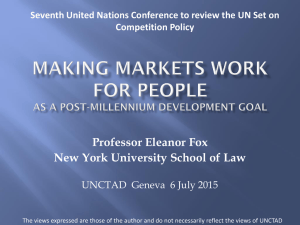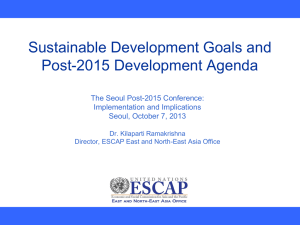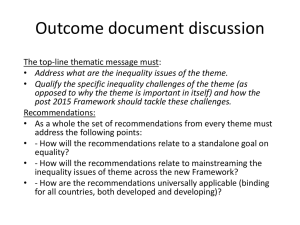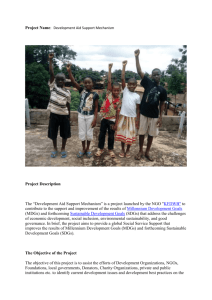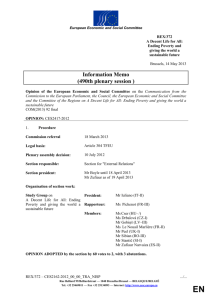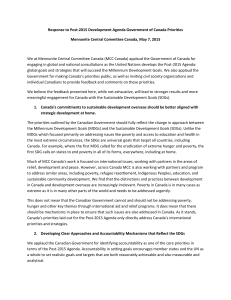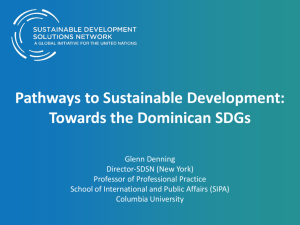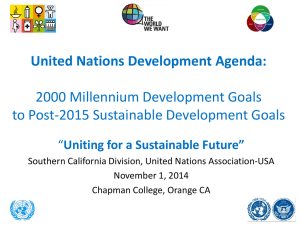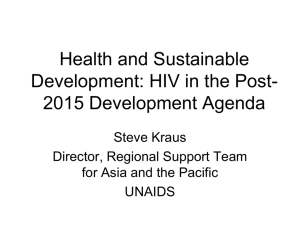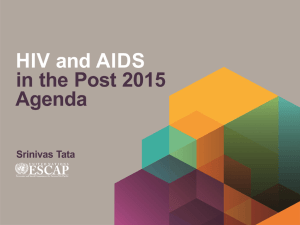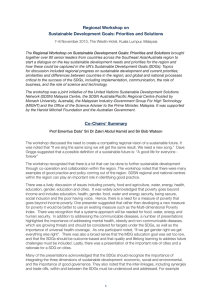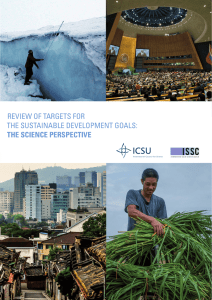Challenges, Opportunities, and Financing
advertisement
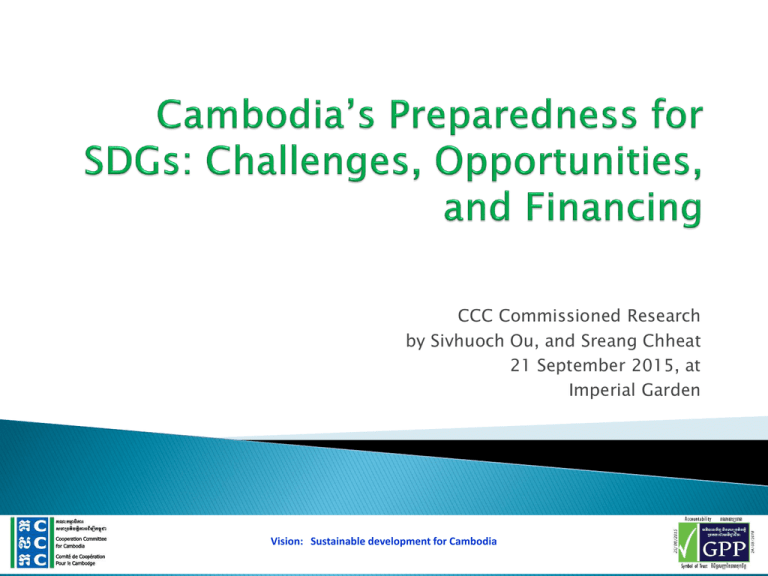
CCC Commissioned Research by Sivhuoch Ou, and Sreang Chheat 21 September 2015, at Imperial Garden Vision: Sustainable development for Cambodia 1 Research Objectives Methodology SDGs in perspective Cambodia, from CMDGs to SDGs SDGs for Cambodia: ◦ Challenges ◦ Opportunities ◦ Financing Key ingredients for SDGs success Recommendations 2 To scrutinise the extent to which Cambodia is prepared to achieving SDGs, analysing existing development mechanisms/ frameworks and policies and the actual implementation 1. Look at tension between SDGs and Cambodia 2. Analyse challenges and opportunities for the localised version, and 3. Unravel the likely sources of fundings 3 Secondary data and primary data; it involves in-depth interviews with stakeholders in the private sector (3), government (2), and development sectors (7), August and September 2015 4 MDGs— ◦ halving poverty, getting primary schooling met for all children, promoting health for mother and son, eradication of gender discrimination, safeguarding the environment and for rich countries, providing foreign aid. Poverty has fallen 3 times, from 47% in 1990 to just 14% in 2015 (UN 2015) Hunger and diseases substantially reduced (Sach 2012) 5 GOAL 1 End poverty in all its forms everywhere GOAL 2 End hunger, achieve food security and improved nutrition and promote sustainable agriculture GOAL 3 Ensure healthy lives and promote well-being for all at all ages GOAL 4 Ensure inclusive and equitable quality education and promote lifelong learning opportunities for all GOAL 5 Achieve gender equality and empower all women and girls GOAL 6 Ensure availability and sustainable management of water and sanitation for all GOAL 7 Ensure access to affordable, reliable, sustainable and modern energy for all GOAL 8 Promote sustained, inclusive and sustainable economic growth, full and productive employment and decent work for all GOAL 9 Build resilient infrastructure, promote inclusive and sustainable industrialization and foster innovation GOAL 10 Reduce inequality within and among countries GOAL 11 Make cities and human settlements inclusive, safe, resilient and sustainable GOAL 12 Ensure sustainable consumption and production patterns GOAL 13 Take urgent action to combat climate change and its impacts* GOAL 14 Conserve and sustainably use the oceans, seas and marine resources for sustainable development GOAL 15 Protect, restore and promote sustainable use of terrestrial ecosystems, sustainably manage forests, combat desertification, and halt and reverse land degradation and halt biodiversity loss GOAL 16 Promote peaceful and inclusive societies for sustainable development, provide access to justice for all and build elective, accountable and inclusive institutions at all levels GOAL 17 Strengthen the means of implementation and revitalize the global partnership for sustainable development 6 Sustainable Development? SDGs, ◦ “the so-called triple bottom line approach to human wellbeing…a combination of economic development, environmental sustainability, and social inclusion” and the trio forces need the support from good governance (Sach 2012) ◦ a world free of poverty, hunger, disease and want,... universal respect for human rights and dignity, the rule of law, justice, and peace— integrated and indivisible, a supremely ambitious and transformational vision Will all good things go together? ◦ a big question, and literature suggests, it might not be the case (a cautious warning) 7 1. 2. 3. Crucial roles and collaboration of both developed and developing nations Post-2015 pays more attention to local contexts—capacity in resource mobilisation from DPs and local sources Emphasis on environmental protection— close to half of the targets, implicitly and explicitly 8 CMDGs Assessment CMDG1: Poverty Met on main indicators CMDG2: Basic Education Most likely to be met on main indicators CMDG3: Gender Met on main indicators CMDG4: Child Health Met CMDG5: Maternal Health Met CMDG6: Communicable Diseases Met CMDG7: Environment Met on main indicators CMDG8: Partnership Met CMDG9: Demining Some way to go 9 Sustained growth of around 7.8% on average, contributing to poverty reduction Gs. 4,5,6=achieved mainly due to its low to nonsensitivity Governance, rule of law and judiciary reforms have not performed well, due to its high sensitivity Past growth accompanied by serious environmental degradation 10 Underachievement of Gs. 2 and 3 linked to underinvestment to the education sector (RGC 2014) Across all the CMDGs, NGOs play and DPs play a critical role—much better in less sensitive areas, than the highly sensitive 11 6 Challenges 4 Opportunities 3 sources of Financing 12 1. 2. 3. 6 Challenges identified: Not pro-green, growth at the expense of forest cut, and environmental degradation mismatch of SDGs’ institutional focus and Cambodia’s reality—external pressure, that can be dangerous for peace and stability and growth SDG’s ambitious goal and target vs. Cambodia’s low quantifying capacity— coordination challenges 13 SDG’s governance focus, and Cambodia’s actual poverty and growth-focused 4. ◦ Rice needs to be produced before rights can be respected Poor and near poor, requires serious attention—3/4 categorised as poor or near poor, malnutrition, and new poor 5. ◦ more investment in health, edu, and social protection Govt, DP and NGOs coordination remains weak 6. ◦ among government agencies, govt-NGOs, and traditional and new DPs 14 1. 2. 4 opportunities envisioned: SDGs for resource mobilisation and setting local agenda focus on sensitive issues such as climate change and environment Governance is improving, especially after the 2013 elections, and in sector such as HIV/AID and Phnom Penh Water Authority 15 3. ◦ 4. ◦ Government has shown strong capacity to own development agenda dealing with both traditional and new donors to address its development needs ASEAN economic community is to benefit from Free flow of goods, services, investment, capital,, and skilled labor, free trade arrangement ◦ Projected, GDP growth by 4.4 percentage points, exports by 5.3 percentage points, private investment by 24.8 percentage points (Itakra 2013) ◦ For international reforms 16 3 sources of financing: 1. Public Financial Management Reform (PFMR) and better tax administration, ◦ Resource Mobilization Strategy (RBS) 2014-18, improving compliance ◦ Revenue to GDP increased from 10.2% in 2000 to 16% in 2015, expected to grow ◦ Progress on expenditure lacks behind, though improving 17 During SDGs, govt has shown its commitment to sustain growth and private sector 2. ◦ SMEs, Industrial Development Policy, its success conditioned on state capacity, and public administrative reform ◦ WB doing business studies for the last several years point to a more stagnant reform; ◦ in addition to peace and stability, reform is needed, quality education for skilled labor key to diversity economic base 18 3. DP, ODA, and FDI ◦ ODA (loan and grant)=about 40% of its budget; in 2013, up to USD1.46 billion;14% executed by NGOs ◦ 2013, for the first time, share of loan was bigger than grant, the trend to continue as the country graduates to Lower middle income country status ◦ NGOs role remains critical, especially to assist those who have not benefited adequately from development, poor and near poor etc. ◦ New bank, non-traditional donors, FDI 19 1. Continue unachieved CMDGs ◦ GOAL 1 End poverty in all its forms everywhere ◦ GOAL 2 End hunger, achieve food security and improved nutrition and promote sustainable agriculture ◦ GOAL 3 Ensure healthy lives and promote well-being for all at all ages ◦ GOAL 4 Ensure inclusive and equitable quality education and promote lifelong learning opportunities for all ◦ GOAL 5 Achieve gender equality and empower all women and girls ◦ GOAL 10 Reduce inequality within and among countries ◦ GOAL 17 Strengthen the means of implementation and revitalize the global partnership for sustainable development 20 Goal 16, ‘promoting peaceful and inclusive societies for sustainable development, provide access to justice for all and build elective, accountable and inclusive institutions at all levels’ will be burdensome, and controversial 1. ◦ feasible standard— SDGs’ environmental sustainability, more research on feasibility is needed 2. ◦ ◦ Environmental sustainability, modernization, and growth Industrial development, construction, tourism and environmental pollution (Gs 6, 7,...15) 21 1. 2. 3. Development partners’ role in mobilizing aid to meet the goal of 0.7% of their respective GNI is highly encouraged A multi-stakeholder forum could be useful in guiding the SDG implementation as well ensuring accountability. Relevant SDGs could be mainstreamed into the decentralization and deconcentration policies, so that the sub national authorities could operate in ways contributing to the overall realization of SGDs. 22 4. 5. Incorporating SGDs into varied Technical Working Group meetings so that the key development stakeholders are constantly reminded of the existing SDGs and could together to achieve the goals. And Capacity building on quantitative work needs to be further strengthened and equipped, especially for the concerned officials at the Ministry of Planning to assist M&E work. 23 24
